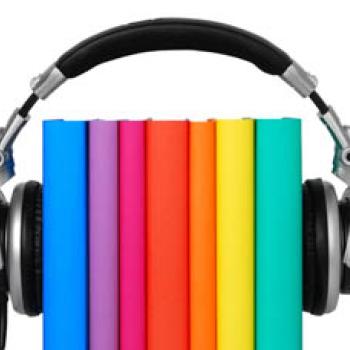Recording Readers Theatre: Developing Comprehension and Fluency With Audio Texts

- Preview |
- Standards |
- Resources & Preparation |
- Instructional Plan |
- Related Resources |
- Comments
Overview
With so many different kinds of texts available to students—from traditional books to podcasts and videos—it is important for teachers to explore various ways of developing students' comprehension skills. This lesson adapts Guided Comprehension as a model to scaffold students' listening comprehension. Students investigate audio texts of mystery stories and evaluate them in terms of both literary and audio qualities. Finally, students create Readers Theatre scripts, which they use to record their own podcasts using vocal qualities and sound effects to add meaning to the text.
Featured Resources
Mystery Cube: This interactive tool helps students identify mystery elements, practice using vocabulary from this genre, and sort and summarize information.
From Theory to Practice
Guided comprehension instruction suggests that teachers should scaffold comprehension in various ways including teacher-directed instruction in both whole-class and small-group settings and teacher-facilitated whole-group reflection and goal setting.
- When evaluating students' performance in Readers Theatre, you can use the following vocal criteria: voice projection, vocal expression, articulation, and rate of speech.
- Readers Theatre becomes more interesting when students use sound effects. Have them practice sound effects prior to using in a script.
Common Core Standards
This resource has been aligned to the Common Core State Standards for states in which they have been adopted. If a state does not appear in the drop-down, CCSS alignments are forthcoming.
State Standards
This lesson has been aligned to standards in the following states. If a state does not appear in the drop-down, standard alignments are not currently available for that state.
NCTE/IRA National Standards for the English Language Arts
- 2. Students read a wide range of literature from many periods in many genres to build an understanding of the many dimensions (e.g., philosophical, ethical, aesthetic) of human experience.
- 3. Students apply a wide range of strategies to comprehend, interpret, evaluate, and appreciate texts. They draw on their prior experience, their interactions with other readers and writers, their knowledge of word meaning and of other texts, their word identification strategies, and their understanding of textual features (e.g., sound-letter correspondence, sentence structure, context, graphics).
- 4. Students adjust their use of spoken, written, and visual language (e.g., conventions, style, vocabulary) to communicate effectively with a variety of audiences and for different purposes.
- 6. Students apply knowledge of language structure, language conventions (e.g., spelling and punctuation), media techniques, figurative language, and genre to create, critique, and discuss print and nonprint texts.
- 8. Students use a variety of technological and information resources (e.g., libraries, databases, computer networks, video) to gather and synthesize information and to create and communicate knowledge.
- 12. Students use spoken, written, and visual language to accomplish their own purposes (e.g., for learning, enjoyment, persuasion, and the exchange of information).
Materials and Technology
- Computers with Internet access and speakers
- Speakers, microphones, and headphones
- Digital voice recording software such as Audacity or GarageBand
Printouts
Websites
Preparation
| 1. | If you are not familiar with the Guided Comprehension strategy, you may want to review Chapter 1 of Guided comprehension: A teaching model for grades 3–8 by Maureen McLaughlin and Mary Beth Allen. Your goal in reviewing this strategy is to help students interact with text. The three main stages in Guided Comprehension include:
|
| 2. | Familiarize yourself with the Readers Theatre strategy by accessing Aaron Shepard's RT Page. If your students are unfamiliar with this strategy, you might teach A High-Interest Novel Helps Struggling Readers Confront Bullying in Schools before beginning this lesson. |
| 3. | This lesson plan uses an audio file of Edgar Allan Poe's story "Purloined Letter" but you may choose a different mystery or horror story based on the needs and abilities of your students. Additional online sources for audio books and stories include: |
| 4. | Visit and familiarize yourself with the interactive, online Mystery Cube. This tool helps students identify mystery elements, practice using vocabulary from this genre, and sort and summarize information. Specific prompts ask students to describe the setting, clues, crime or mystery, victim, detective, and solution. The tool also includes a planning sheet designed for students to use before they actually get on the computer. Bookmark this tool on the computers students will be using. |
| 5. | If you will be using stories by Edgar Allan Poe, visit the sites listed in the Resources section for information about his life and work. You may want to bookmark some of the resources you find for your students to use. Print off and make a copy of "The Purloined Letter" for each student in your class. |
| 6. | Arrange to use a computer with Internet access and speakers during Session 1. Reserve three or four sessions in your school's computer lab (see Sessions 3 through 6). Your students will be creating and editing podcasts, so you may want to schedule additional time in the computer lab as well. If you are not familiar with how to create and edit podcasts, consult with your school's media specialist and check out the following online resources:
|
| 7. | Print and make a copy of the Before, During, and After Listening and Sound Effects Practice sheets for each student in your class. You will also need to make two copies of the Evaluating the Audio sheet for every four students in your class (groups of four use this sheet to evaluate two other groups' work). |
Student Objectives
Students will
- Develop listening comprehension skills by using and adapting reading comprehension strategies to understand audio texts
- Identify vocal qualities that make audio texts more understandable and interesting
- Evaluate audio texts in terms of genre and vocal qualities by listening to the texts and recording their ideas
- Apply what they have learned about vocal qualities and sound effects to create their own podcasts
- Use Readers Theatre as a strategy to develop story understanding and reinterpretation
- Work collaboratively to create a podcast
Session 1
This session uses the story "The Purloined Letter" but any other mystery story with corresponding downloadable audio file can also be used.
| 1. | Predicting. Before listening to the audio file, activate students' background knowledge and predicting skills.
|
| 2. | Asking questions. Distribute the first page of the Before, During, and After Listening sheet. Students should use it to review the six mystery concepts from the Mystery Cube tool and generate detail-searching questions about the story to help guide their reading. |
| 3. | Making connections. Ask students to make the following connections:
|
Session 2
| 1. | Have students review their predictions, questions, and connections from the previous session. |
| 2. | Making connections. Distribute the second page of the Before, During, and After Listening sheet. Ask students to continue making connections as they listen. |
| 3. | Visualizing. Ask students to make mental pictures about what is happening while they listen. Tell them to keep the questions they generated in Step 2 about setting, detective, victim, crime, clues, and solution close at hand so they can do a Quick Draw or Quick Write as they imaging the setting, characters, and plot. (See Quick Write/Quick Draw for an explanation of this strategy.) |
| 4. | Knowing how words work. Remind students to jot down any words they do not know as they listen and to use context clues to figure out what the words mean. They should keep a bank of these words to explore with the group after listening. |
| 5. | Monitoring. Have students ask themselves if the story makes sense. They should be able to follow the sequence of the story. Encourage them to jot down notes or create a map as they listen. |
| 6. | Play "The Purloined Letter"; students listen and take notes. |
| 7. | Summarizing. As soon as the story is finished, distribute page 3 of the Before, During, and After Listening sheet. Ask students to fill it out and then to participate in a large-group discussion about any difficulties they may have had with comprehension or unfamiliar vocabulary. Ask students to share their best comprehension strategies. Questions for discussion include:
|
Session 3
During this session, have students work in guided groups of four. Because students will be participating in a creative collaborative project they should be allowed to choose their own groups. Ideally this session takes place in a computer lab.
| 1. | Summarizing: Have students work in their groups to fill in the Mystery Cube summarizing the text using their notes from Session 2. They should print and assemble their cubes when they are finished. |
| 2. | Once students have filled out the cube, have them participate in summarizing discussions in their small groups. Move from group to group assisting students with their questions and guiding their conversations. Next, ask the groups to share their ideas with the whole class. Questions you might ask include:
|
Session 4
| 1. | Evaluating. Have students listen again to "The Purloined Letter", this time reading along in the hard copy and answering questions from the Evaluating the Audio sheet. Students should work on this independently and then share their ideas once the audio is finished. |
| 2. | After students evaluate the audio, have them explore how the audio could have been different by asking "what if" questions. For example, what would have made the recording more interesting? What sound effects could have been used? What areas could have been more interesting or understandable with a different tone of voice? |
Sessions 5 and 6
These sessions include student-centered guided comprehension routines and teacher-facilitated whole-group reflection. Students use their completed Mystery Cubes and their completed Evaluating the Audio sheets as well as any notes they took on the text version to plan their script.
| 1. | Explain to students that they will make their own audio recording of a section of the story, which will be evaluated using the questions on the Evaluating the Audio sheet. |
| 2. | Have students get into their groups and choose a section of the story that includes dialogue to record. Next, have them practice some of the sound effects from the Sound Effects Practice sheet. Talk about what effects they might use in their recording. Remind them to consider where in the story they might use the effects. You might want to have them review their printed version of the story and mark where the effects should go. |
| 3. | Next, groups of students will prepare to read the story as a Readers Theatre. Using their printouts of the story, they should decide on parts (both narration and specific characters), tone of voice, and sound effects they will use in their audio recording. Remind them to focus on the elements of mystery and accentuate these with proper tone of voice or sound effects that add to the meaning of the story, the feeling of the setting, the suspense of the mystery, the emotions of the victim, and change in atmosphere throughout the story. |
| 4. | Help students record their stories. These can either be recorded on a tape recorder, digital recorder, or directly onto the computer to create MP3 files. |
| 5. | Once students have recorded their scripts, have them spend time listening to their classmates' recordings and comparing them with their own versions. As a group, they should use the Evaluating the Audio sheet to evaluate at least two other recordings. |
| 6. | Have a whole-class reflection where students share their experiences. Questions for discussion include:
|
Extensions
- Students can use the Mystery Cube and create an outline for their own mystery, write a script, and follow the same format as outlined in Sessions 5 and 6 to create an audio recording.
- Scaffold students' reading using another one of Poe's works. This time, give less assistance to students. Have them work in guided-listening groups, working through the listening as you circulate among the groups. Provide them with a framework with questions for the specific story.
Student Assessment / Reflections
- Collect and review the Evaluating the Audio sheets to see how well students were able to review the work of their peers and how well they understand the qualities that make a strong audio presentation of a story. After comparing your evaluations with those of students, meet individually with each group to discuss ways to make their podcasts more interesting and understandable.
- Use the Before, During, and After Listening sheets to evaluate individual student’s understanding of the story.
- Have students complete self-assessments using the Readers Theatre Self-Evaluation and the Working With My Group form.

